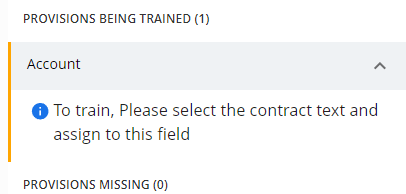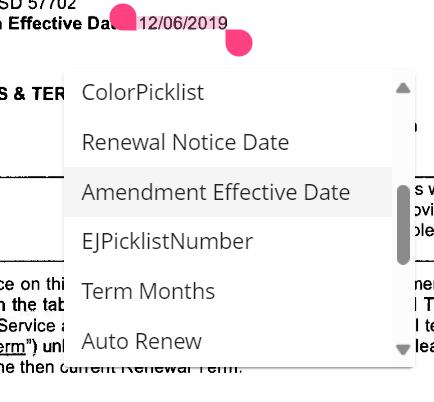Download PDF
Download page Reviewing Imported Documents.
Reviewing Imported Documents
You can review and correct the clauses and fields extracted from imported documents. Discovery AI converts all scanned or uploaded documents to PDF format for scanning and review. Provisions and other significant text are highlighted for review in an in-app PDF reader. For each detected clause you review, you can accept the extract, reject the extract, edit the extract, or flag the extract for review.
To review imported documents
Enter review mode:
- From the home screen, click the folder icon to access the Project Dashboard, then open a file marked "Ready For Review."

From an open contract in Conga Contracts, Contracts for Salesforce, or Conga CLM click Review Intelligent Document Import (if available).
- If the administrator has configured it and if you are named as a reviewer, you can also check out batches of files by clicking the + GET NEXT BATCH button.
Passages from the extraction map that the AI has identified are highlighted in the text and identified by mapping category under the PROVISIONS FOUND heading in the review column to the right. For example, if a contract contains an amended effective date field, as has been mapped in the extraction map, that field is highlighted in the text and appears in the right column under its field-name heading.

In this mode, you can offer feedback on extraction quality directly to the AI (using the thumbs-up/thumbs-down icons), mark a field or clause as reviewed (approved), or flag the entry for further attention.
For clauses, you can also remove the checkmark from the left checkbox to withhold feedback on the extraction. This means the extraction result will not be used to train the AI.

The AI's confidence score is indicated on the left, using color-coded bars:
Mandatory fields are indicated by "Required" indicators. Your review cannot be completed until these required values are populated, either automatically or through manual editing.
![]()
Provisions mapped for the document type that have not been found in the document are also called out in the review column below the found items, under the PROVISIONS MISSING heading.

Provisions that are in training are also called out in a special section, PROVISIONS BEING TRAINED.

For more on this, see Training Provisions.
Selecting each item raises a summary of the item's name if it is a field or a clause, and a comparison of extracted values and their interpreted value.

For clauses, extracted clauses are compared to standard clauses and the match/non-match results displayed. Clauses that match are displayed with a "Matches with standard clause" heading. Clauses that do not match are displayed under a "Does not match standard clause" heading.

You are offered the ability to edit the extraction. Use this with care.
When the AI reviews documents, it compares the ingested text to known samples to find matches and close correlates to sample provisions. You can review its performance, gain insight into how it is making such comparisons, and select the best of several alternative clauses using the Compare or Edit Clause feature. Clicking the down-arrow icon adjacent to an extracted clause exposes the standard clauses that the AI recognizes as close matches.

Clicking COMPARE OR EDIT CLAUSE exposes the Clause Assignment window, which contains four views of an extract: the extracted clause itself, the standard clause against which it was compared (this can include the language of custom provisions), and the similarities and differences between the extracted clause and the standard.

The Extracted and Standard fields are as described:

Beneath these, the AI describes the similarities and differences between the extracted and standard clauses:

Searching Extractions
Clicking the search (magnifying glass) button opens a search feature that enables you to narrow the list of visible entries in the review column.

All entries in the review column can be expanded by clicking the down arrow, exposing the text of the found provision and some review tools.
 For each found entry, you can:
For each found entry, you can:
- Click the trash can to delete the entry (this does not alter the underlying agreement, just the metadata). This feature is disabled for required fields.
- Click the pen icon to edit the entry (to remove extraneous scan artifacts from the entry, for example).
- Flag the item for later review. This marker remains visible even when the entry is collapsed.
Missing items offer an input field (for clauses, a text box; for fields, a menu, date picker, or text field).

Clicking text captured by the extraction takes you to the page in the document and highlights the extracted text.
Details Tab
The Details tab, adjacent to the Review tab in the document review interface, contains these fields:
- Document Name/Record Type
- Review Level
- Review completed by
- Owner
- Assignee
- Comment
Some are filled in by the AI, while others are completed using manual pull-downs. The reviewer can identify the record type, designate an assignee, and comment on the document.
Editing Provisions
For each provision, you can edit or manually populate an entry.
To edit an extracted provision
- Click the "down" arrow to open the entry.
- Click the edit (pen) button to open the provision for editing.
- Edit the provision (This edits the clause, field, or line item's metadata, not the contract text).
Note
The Administrator may have configured the provision to insert a default value if Discovery AI could not find the provision's text in the document. Such values are clearly indicated in the reviewer UI. You can edit these provisions like any other.
- When you are done editing, click the Accept (check mark) button, confirming that it has been accurately extracted, marked, and categorized. To abort the edit, click the X.
- Edit another entry or click MARK AS REVIEWED.
To assign and edit a provision that has not been extracted
If a provision has been defined as manual-only or if the AI has missed a passage, you can manually assign a provision to a passage in the contract by one of two methods:
Note
The Administrator may have configured the provision to insert a default value if Discovery AI could not find the provision's text in the document. Such values are clearly indicated in the reviewer UI. You can edit these provisions like any other.
Copy from the Contract
- Click the "down" arrow to open the entry.
- Click the edit (pen) button to open the provision for editing.
Locate the relevant clause, field, or line item in the contract.
Tip
Use the built-in search feature to locate contract terms quickly.
- Either:
- Copy the information from the contract to the provision field and format it as you will, or
- Highlight the provision text, copy it and paste into the clause text box.
- The provision text appears in the right column, ready for editing.
- If it is necessary, edit the provision as described above.
- When you are done editing, click the Accept (check mark) button, confirming that it has been accurately marked and categorized.
Edit another entry or click the Review Complete button.
Tip
If you click the check mark icon to accept a clause in error, you can un-check it (and all other acceptances from this session) by clicking the Cancel button.
Highlight in the Contract
- Review the missing or manual-entry-only provisions in the PROVISIONS MISSING column to the right and locate a provision to fill.
- Search and highlight the provision text in the contract.
- Right-click the highlighted provision text and select the correct provision type from the drop-down menu.

- The provision text populates the provision entry, which moves to the PROVISIONS FOUND column.
- Edit or approve the selected provision by clicking the pen or checkmark icons.